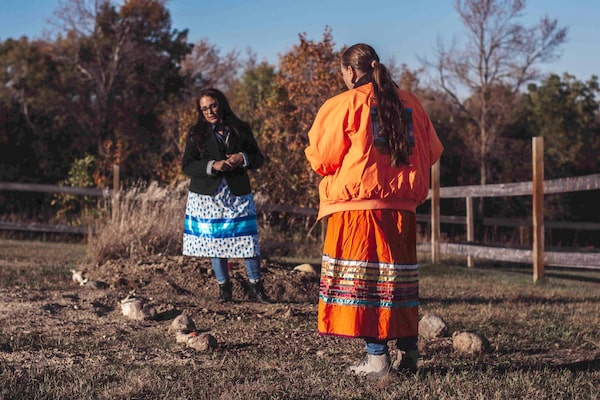
Tamara St. John and Dianne Desrosiers worked tirelessly to bring the remains of two boys to these graves in South Dakota, more than 140 years after they died at a residential school in Pennsylvania.Willow Fiddler/The Globe and Mail
When Tamara St. John saw a boy’s teeth and skull being exhumed from his 142-year-old grave at a cemetery in Carlisle, Penn., she cried. The South Dakota state legislator from the Sisseton-Wahpeton Oyate tribe had stood in the pouring rain for almost 12 hours, watching over the painstaking process that would bring home her “boys” – Amos LaFromboise and Edward Upright.
On Nov. 6, 1879, Amos and Edward were among the first students to arrive at the Carlisle Indian Industrial School, the first government-run boarding school for Indigenous children in North America. Just 20 days later, Amos, 13, was dead from unknown causes. Edward, 12, died a year and a half later in May, 1881, from measles-related pneumonia.
According to school records, the boys were to be enrolled for three years. The reason for their discharge is listed as “died.”
Their burials in Carlisle had always been known: Both boys were sons of highly respected Sioux leaders – Amos from what is today the Sisseton-Wahpeton tribe of Lake Traverse Reservation, S.D., and Edward from the Spirit Lake tribe in North Dakota.
Their names were clearly etched into cream-coloured headstones in the Carlisle Barracks Main Post Cemetery, located on a still-active U.S. military base. But the exact contents of the graves weren’t known until they were dug up and examined by forensic experts in September.
The remains of Amos – a partial knee fragment – and Edward – an almost complete skeleton – were then returned to their Dakota home for the proper burial they never had.
It was the culmination of six years of negotiation between the U.S. Army and the Sisseton-Wahpeton tribe, led by Ms. St. John and Dianne Desrosiers, a tribal historic preservation officer. Both grew to love the boys as their own.
“Because we took action to bring them home, there’s a statement there that these boys are not abandoned. They’re not forgotten. They matter,” said Ms. St. John, the daughter of a boarding-school survivor.
It was the first repatriation of children from Carlisle for the Sisseton-Wahpeton and Spirit Lake tribes, but several other tribes have brought home their children’s remains from Carlisle since 2016.
The American boarding schools were part of an aggressive system of assimilation that served as the model for Canada’s Indian residential schools. The repatriation of remains from the American schools is part of the work tribes south of the border are doing as part of their healing process.
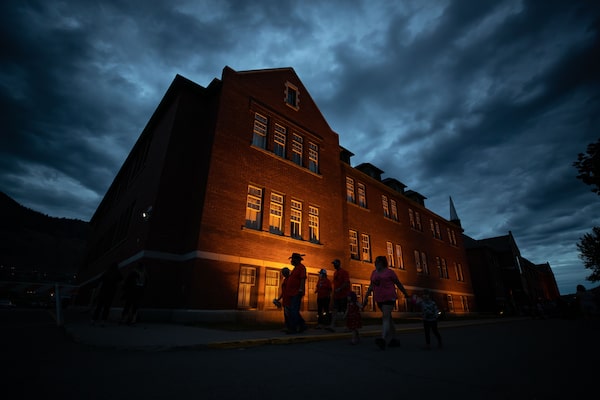
Findings at Kamloops Indian Residential School, shown in 2021, rekindled Indigenous efforts to identify the people buried in unmarked graves.Darryl Dyck/The Canadian Press
The efforts by Ms. St. John and Ms. Desrosiers were already under way when the Tk’emlúps te Secwépemc First Nation near Kamloops, B.C., announced in May, 2021, that it had discovered around 200 probable unmarked graves on the grounds of the former Kamloops Indian Residential School using ground-penetrating radar.
That news prompted another reckoning in Canada of the lasting impact of the residential school system, which the Truth and Reconciliation Commission brought into painful clarity for the country beginning in 2008.
Since the Kamloops announcement, some 15 Indigenous nations and groups from British Columbia to Northern Ontario have conducted similar radar surveys that found a further 4,137 potential burial sites, according to an interim report in June by Kimberly Murray, the Independent Special Interlocutor for Missing Children and Unmarked Graves and Burial Sites associated with Indian Residential Schools.
What to do next has been fraught as the decision over whether to exhume or leave graves undisturbed is considered by survivors, families and communities. Only one group in Canada so far – Pine Creek First Nation in Manitoba – is known to have made the difficult decision to dig.
The excavation in the basement of Our Lady of Seven Sorrows Catholic Church – the only building left standing on the site of the former Pine Creek Indian Residential School – found no evidence of human remains this past summer. But the nation’s leadership is considering whether to dig at other spots around the church and school where radar detected possible anomalies.
In the U.S., Ms. St. John said the news from Kamloops was shocking and reaffirmed her tribe’s own efforts to reveal their boarding school truths and history.
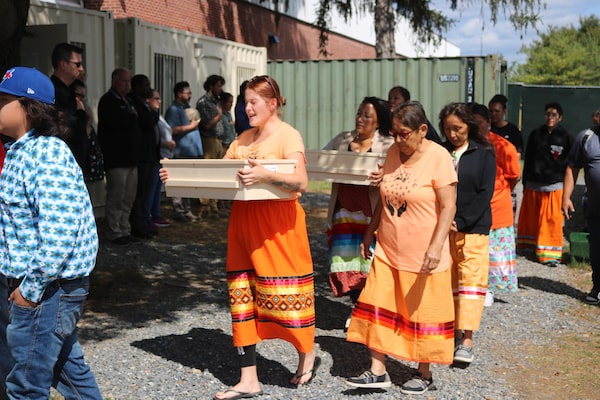
Angeline Wanna and grandmother Lillian Wanna, members of the Buffalo Heart Women, carry the remains of Amos and Edward at last September's disinterment at Carlisle Barracks Cemetery.
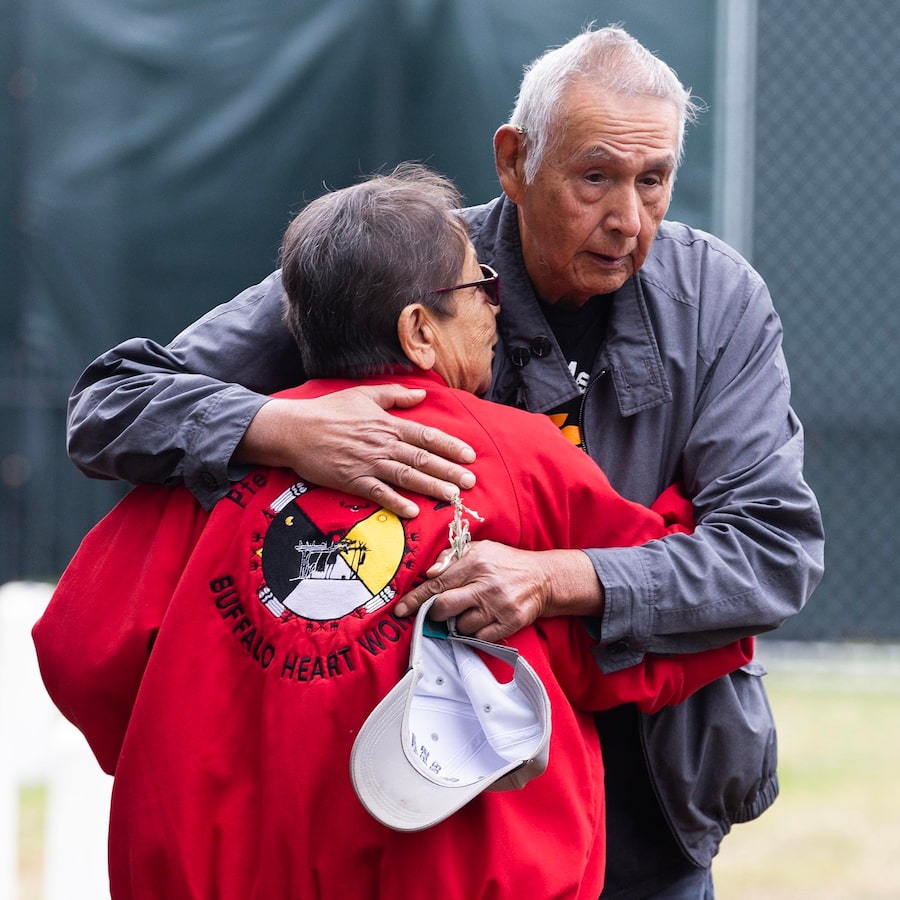
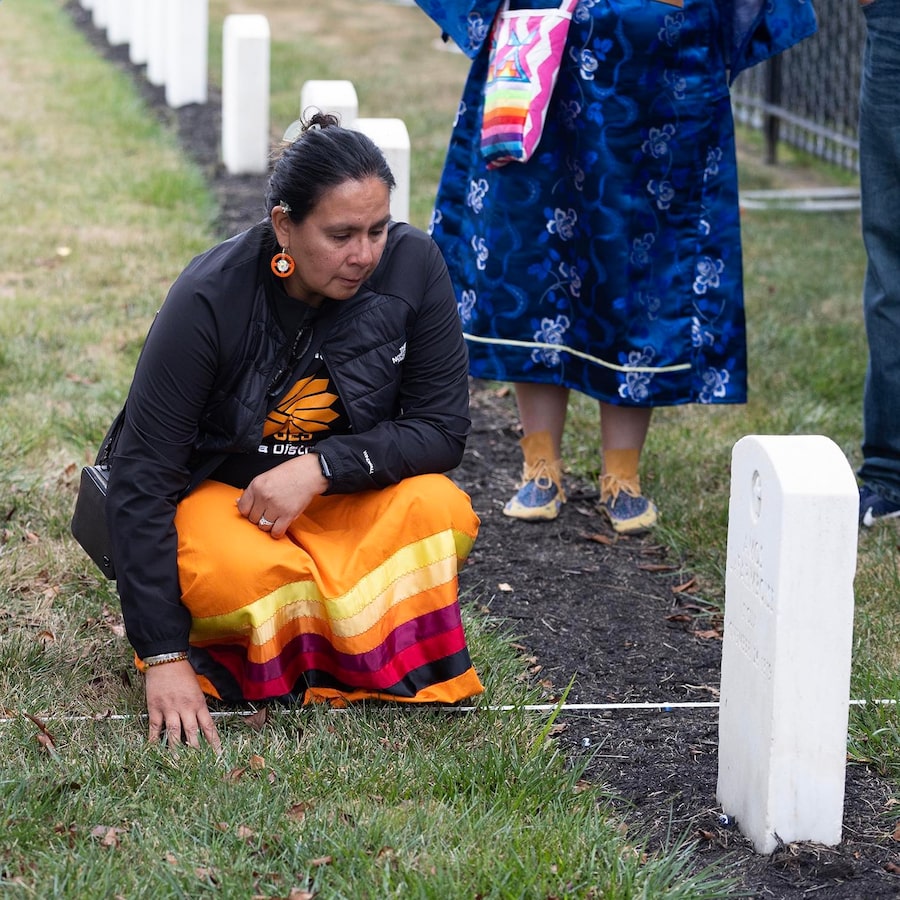
The Carlisle Indian Industrial School was the first off-reserve boarding school in the United States, founded by military officer Richard Pratt in 1879. It became a model for the Indian residential school policy implemented in Canada by John A. Macdonald and Duncan Campbell Scott, the federal Indian Agent who pushed assimilation. The 1879 Davin Report recommended that Ottawa follow the U.S. example at Carlisle and contract churches to run boarding schools aimed at assimilating Indigenous children.
Pratt is notorious for his assimilation policy to, in his words, “kill the Indian, save the man.” The phrase was later adapted in Canada as “kill the Indian in the child” to describe the residential school system.
The U.S. federal government had been funding and supporting schools on reserves as early as 1819. According to a 2022 report by the U.S. Department of the Interior’s Bureau of Indian Affairs, 408 Indian boarding schools operated across 37 states and territories until 1969. The report identified marked and unmarked burial sites at approximately 53 of those sites.
It expects those numbers to increase. The non-profit National Native American Boarding School Healing Coalition says there were at least 523 Indian boarding schools in operation since 1801, including those that weren’t funded or supported by the U.S. government but still aimed at assimilating Indigenous children, usually through religious indoctrination.
Amos and Edward were among the first of more than 10,000 Indian children from more than 100 tribes to attend the Carlisle Indian Industrial School before it closed in 1918. The two boys travelled close to 2,000 kilometres from their families and Dakota tribes, where they likely would have become leaders like their fathers.
Amos had originally been buried in a different local cemetery and moved a month later, school records show, because the first site was for “white persons only,” and there was no legal authorization for him to be interred there as an Indian youth.
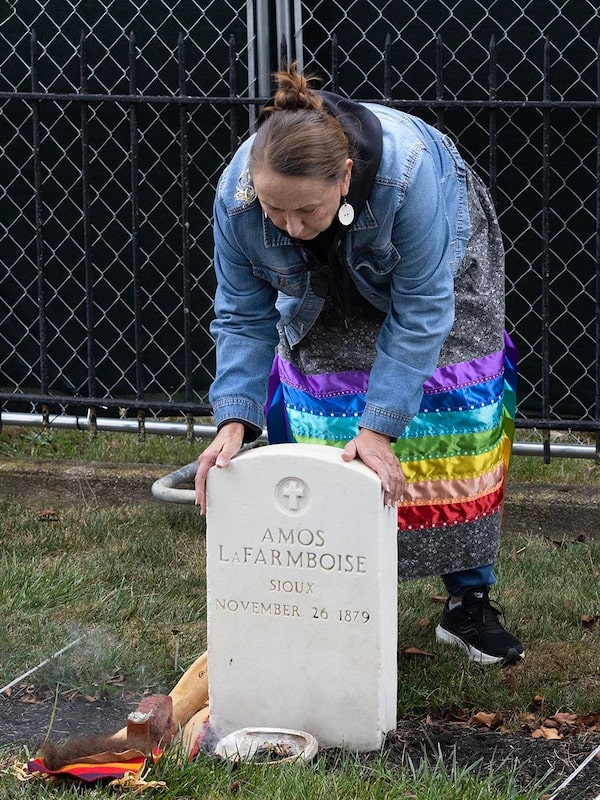
Dianne Desrosiers looks over Amos's gravestone.Courtesy of Tamara St. John
The U.S. Army began its Carlisle Barracks Disinterment Project in 2016 after receiving requests from the Northern Arapaho Tribe to repatriate its children buried there. To date, 32 children have been repatriated to several Native American and Alaskan tribes as the military works with tribal nations to return 146 known Native children buried at the Carlisle site, said Renea Yates, director of the Office of Army Cemeteries.
She said it’s up to the tribes if they wish to repatriate remains of the children buried in Carlisle, and that some families and tribes have chosen not to do so and to leave the remains there as reminders of what took place.
However, the army also said that its regulations would require the repatriation work to be conducted by the closest living relative. Ms. St. John and her team argued the Native American Graves Protection and Repatriation Act, implemented in 1990, allowed the tribes – not a relative – to do the repatriation work.
The army maintained the act didn’t apply in this instance and its opposition threatened a significant obstacle.
Ms. St. John garnered the support of the Native American Rights Fund to further their case and avoid going to court.
The two sides eventually came to an agreement to ensure that Amos and Edward would be repatriated in a culturally appropriate and expeditious manner.
“We wanted certain things done and we wanted to be able to do things a certain way and when they came back, they said they’ll agree to all of it,” said Ms. Desrosiers.
Spirit Lake Chairwoman Lonna Street signed the agreement with the army along with Sisseton-Wahpeton Oyate Chairman J. Garret Renville. Spirit Lake agreed to bury Edward at the Sisseton repatriation grounds with Amos.
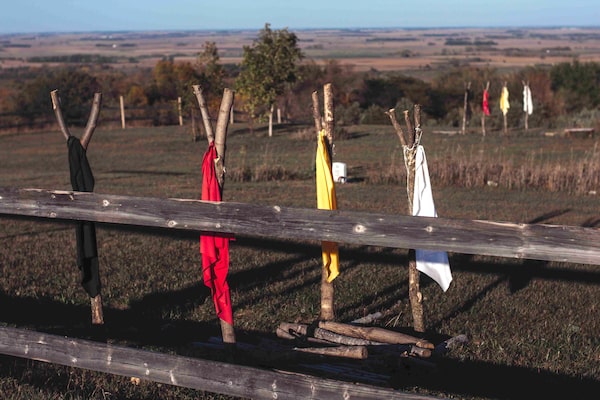
For the traditional Dakota funeral, Amos and Edward's remains had to be lifted onto scaffolding for four days before being buried. In Amos's case, there was only a kneecap to be interred; Edward's skeleton was nearly complete.Willow Fiddler/The Globe and Mail
Within days of signing the agreement, the tribal societies arrived on site at the Carlisle cemetery and an army official started plotting out where they could set up a sweat lodge.
“The idea that we were going to be there with ceremony, with prayer, with song, with everything that is Indigenous at this place that at one time would have been outlawed,” said Ms. St. John.
“It was ironic,” said Ms. Desrosiers.
The tribes already knew what to do when the time came, said Ms. Desrosiers who has worked with the Tribal Historic Preservation Office since the Sisseton-Wahpeton’s first repatriation of human remains from the Smithsonian Institution in 1991.
Their customs and protocols have been established by local tribal societies such as the Buffalo Heart Women and the Kit Fox Society, groups of women and men, respectively, with the sacred knowledge of different roles and responsibilities within the tribes, including around highly sensitive events such as burials and disinterments.
“This is why the Buffalo Heart Women, they’re the strongest of the strong. That’s why you women have to do this. There is nobody else,” Ms. St. John recalled being told by an elder when things got tough emotionally and spiritually. “And the Kit Fox, they’re the bravest of the brave. They’re the protectors. This is why it’s you guys who do this.”
The agreement with the army outlined a collaborative plan for the tribes to take final custody of the boys’ remains in a way that upheld army regulations and prioritized traditional Dakota customs. The army’s archeological and forensics teams and the tribes’ forensic analyst and tribal societies met ahead of time.
Once the caravan of four passenger vans from the Sisseton and Spirit Lake tribes arrived at Carlisle, construction of a sweat lodge began. The tribes brought willows, rocks and other supplies while the army provided firepits, fire-burning wood and canvas tarps.
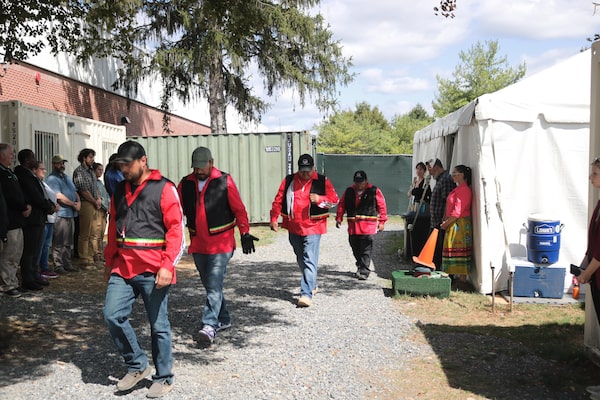
Members of the Dakota Kit Fox Society take part in the Carlisle ceremony in September.Courtesy of Tamara St. John
On Sept. 17, the tribes conducted traditional opening ceremonies and broke ground on the graves of Amos and Edward.
The army’s archeological team conducted the exhumations while the Kit Fox Society stood guard. Tribe members and observers were allowed to watch from a safe distance or wait in a tent that was erected for them.
After the analysis team recovered the remains, they were placed onto wooden trays with red cloth for the Buffalo Heart Women to carry to the analysis tent, escorted by the men of the Kit Fox Society. Tribal elders advised on the traditional aspects of handling the remains.
The army’s anthropology team inspected the remains to determine the gender, estimated date of death, and age of the child. Its findings were biologically consistent with the information contained in Amos’s and Edward’s student and burial location records.
The agreement had also included time and space for traditional ceremony in the event the remains were found to be inconsistent with Amos and Edward, as was the case with another child’s grave exhumed at the same time.
When it was confirmed that it was Amos and Edward, the Buffalo Heart Women prepared the remains in red cloth for ceremony, placing them in pine boxes wrapped in buffalo robes. The army also conducted its own transfer ceremony.
Ms. Desrosiers took final custody of Amos while a representative from Spirit Lake took Edward before handing them over to the Kit Fox Society for transportation from Carlisle to Agency Village, S.D.
Closer to home, the boys were transferred to a horse and carriage at the location from which they are believed to have departed for Carlisle. They completed the journey back home along the dusty gravel roads leading to the repatriation grounds, where Amos and Edward were buried beside each other in a four-day traditional ceremony.
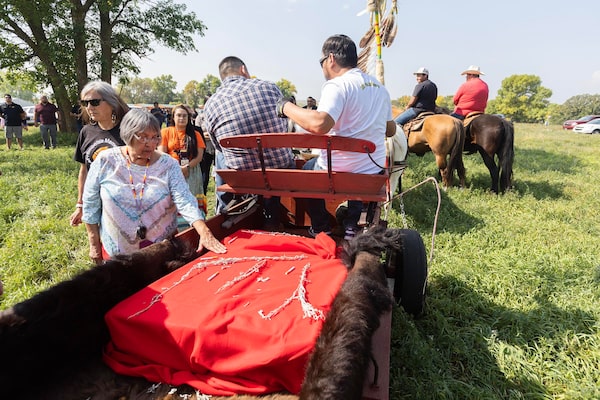
Susie Amos, councilwoman for the Sisseton-Wahpeton Oyate tribe, greets the remains as they are led by horse and carriage onto the burial grounds.Courtesy of Tamara St. John
Ms. St. John said the work to repatriate Amos and Edward is part of an all-encompassing fight to protect sacred and cultural tribal resources, including burials, and to include all elements of spirituality and culture to share with younger generations. Burying Amos and Edward at Sisseton’s repatriation grounds not only honours the boys and their cultures. The fight to lay them to rest in a meaningful way has also set a precedent for other tribes to do the same.
The teaching of tribal history needs to be amplified from the side note that it currently represents, said Ms. St. John. “It’s not acknowledged as the important part of American history that it should be. It’s not afforded its rightful place.”
She said it’s vital for all Americans to learn about the impact historic policies such as the boarding school system had on Indigenous peoples and tribes, especially when it comes to statistics on rates of suicide, incarceration and addiction.
“What you’re seeing is our recovery. We are in a recovery stage,” Ms. St. John said. “The best that you can do is support that with understanding and help to find solutions to remove obstacles that might be in our way. Believe in us.”
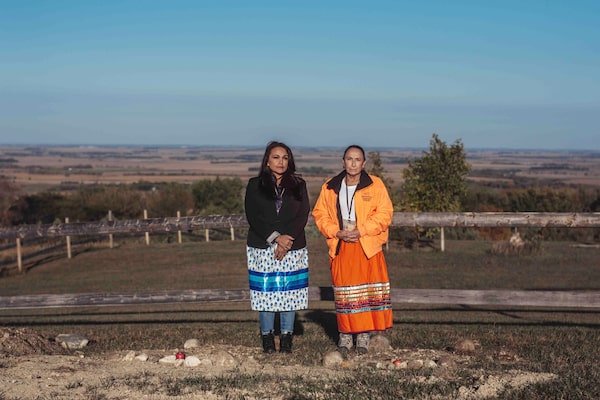
Willow Fiddler/The Globe and Mail